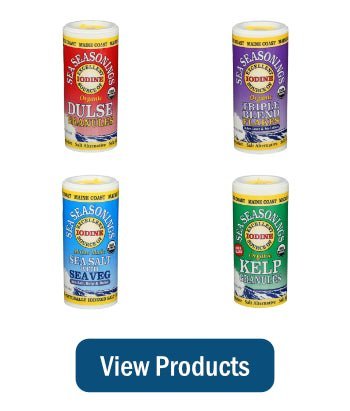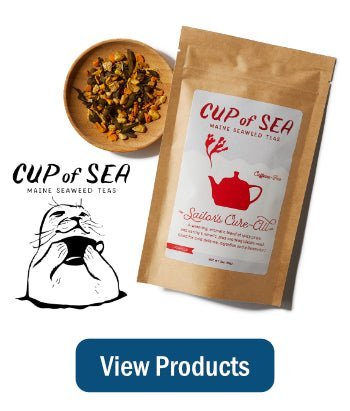As you may have guessed, this article is about seaweed and alcohol, not ancient seaweed ghosts. Seaweed’s abundance of carbohydrates makes it a promising candidate for producing plant-based bioethanol for energy. In theory, those same carbohydrates could be fermented to make an intoxicating spirit for human consumption. Craft brewers and mixologists (people who mix and invent cocktail drinks) have discovered that the complex flavor profile of sea vegetables also adds interesting dimensions to beer and spirits.
Before we dive into the topic in greater detail, we should give credit where it’s due. Some of the information presented here comes from S. Kraan in Chapter Six of the text “Seaweed in Health and Disease Prevention” (2016; Edited by Joël Fleurence and Ira Levine). We highly recommend this book for anyone wanting a good seaweed reference text for their library!
Seaweed Biofuel
The very first Henry Ford Model T was designed to run on either ethanol or gasoline. At the time, gasoline wasn’t widely available, but any farmer could make their own ethanol by fermenting corn or some other biomass. Eventually, gasoline won the day because it is more energy dense than ethanol. Gasoline has about 33% more energy, meaning you’ll get more miles per gallon from gasoline than from ethanol. Lobbying and campaign contributions from the petroleum industry also played a role in gasoline’s eventual dominance as the fuel of choice.
Ethanol enjoyed a brief resurgence during World War II when gasoline was needed for the war effort, and then made what appears to be a more lasting comeback in 2005 when Congress passed the Renewable Fuel Standard, which established minimum levels for the use of renewable fuels. Ethanol is considered renewable because it’s a biofuel made by fermenting biomass. It takes only one summer to grow a crop of corn to produce ethanol, vs millions of years for nature to make fossil fuels. Ethanol is also a low-cost fuel additive for raising octane, and gasoline blended with ethanol emits fewer greenhouse gasses (but more of certain other pollutants). Today, over 97% of all gasoline sold in the US contains 10% to 15% corn bioethanol. In Brazil, gasoline contains at least 25% ethanol produced from cane sugar. Flex fuel vehicles can run on 85% to 100% ethanol.
There are drawbacks, though, to using agricultural crops such as corn or sugar to make ethanol for fuel. The most obvious one is this practice removes precious agricultural land from food production. It also requires all the usual crop inputs such as fertilizer, pesticides/herbicides, and fresh water. These drawbacks have led scientists to investigate seaweed as an alternative source of biofuels.
Seaweed has a high carbohydrate content, most of which in theory could be fermented to produce ethanol and other biofuels such as methane. We already know how to farm some species at very large scale, such as kombu kelp in Asia, or red seaweeds such as Kappaphycus, grown in the South Pacific for carrageenan. Unlike corn or cane sugar crops, seaweed mariculture requires no agricultural land, fertilizer, chemicals, or fresh water. Seaweed contains almost no lignin, a complex polymer that forms the structural support tissues of most land plants. Lignin binds and protects fermentable plant sugars and is itself difficult to break down, which makes it an obstacle to efficiently producing ethanol from plants. Another advantage of seaweed is that it removes carbon from the ocean, potentially making it a carbon neutral fuel.
Governments around the world have sponsored research to address the key technical challenges involved with producing seaweed biofuels. Here in the US the Department of Energy has funded large seaweed biofuel projects on both the east coast (sugar kelp) and the west coast (giant kelp macrocystis). Of course, there are always skeptics, and one of the issues they bring up is that seaweed’s value for other purposes makes it too expensive to be grown for fuel. This brings us to our 2nd topic…seaweed for booze!
Seaweed Booze
Besides being a fuel, ethanol is also the intoxicating ingredient in alcoholic beverages. In theory, then, seaweed could be fermented to make alcoholic beverages instead of biofuel, perhaps a seaweed wine, or fermented and distilled to make a seaweed liquor. S. Kraan reports that a tribe of American Indians living on Orcas Island in Puget Sound used gigantic bladder kelp as a pot still. Though the primary purpose appeared to be to use the kelp bladders, with their long, hollow stems, as a distillation apparatus, S. Kraan speculates that the bladders themselves contributed a certain amount of alcohol through fermentation. S. Krann also mentions a report of the inhabitants of Kamchatka in Russia brewing an alcoholic beverage, described as “evil-tasting”, from dulse (which itself is quite delicious). Perhaps it’s the evil taste of the final fermented product that prevents seaweed from being one of the many carbohydrate sources commonly used by humans to make alcohol.
Nevertheless, a few intrepid souls have apparently succeeded in brewing palatable alcoholic beverages with seaweed as the base ingredient. A company in Ireland offers “Sea Fruit wines” produced from kelp, dulse, Irish moss, wild nori, and ulva. Their website describes the flavor as being delicate and closer to that of water than wine, with an energizing effect. In Germany, marine biologists developed a seaweed wine made from sugar kelp, described as “an intense terroir wine with a marzipan flavor”, much like a fine sherry. Not only is this wine reportedly pleasant, it also confers minerals, iodine, and all the other health benefits of seaweed. If you have access to fresh seaweed, you could try this recipe to make wine from it. Be sure to check out the videos found at the recipe link…informative and highly entertaining!
More commonly, though, seaweed is used for adding flavor to wine, beer, and spirits, rather than as the main ingredient. Craft beer brewers in particular seem to enjoy experimenting with seaweed flavors. One of the first companies to sell seaweed beer here in Maine was Marshall Wharf Brewing Co. in Belfast, who made a well-received Scotch Ale they called Sea Belt. Closer to home for us, our friends at Fogtown Brewing Company have made a Maine Grain Seaweed Saison, with the recipe generously shared here. (Hint: MCSV sells all of the seaweed ingredients!). In our neighboring state of New Hampshire, the Portsmouth Brewery made a kelp infused brew they called Selkie, which proved to be quite popular.
Inspiration for these American seaweed beers comes from Scotland, where Williams Brothers Brewing Company offers a deep red seaweed ale called Kelpie. Kelpie ale is made by directly mashing bladderwrack with malt, as opposed to using it as a boil additive or in the secondary ferment. Of course, Scotland and Ireland have a long history of using Irish moss seaweed in beer, but as a clarifier and not a flavor enhancer. Many home brewers are familiar with using Irish moss for this purpose.
It’s also in Scotland where we see some fine examples of seaweed infused spirits. Gin is a particularly suitable spirit because it’s always flavored with botanicals, usually juniper berries but often with other botanicals as well. Isle of Harris Gin is a Scottish gin infused with sugar kelp, and it was voted No. 1 by the Scottish Gin Society. In Canada, Newfoundland Distillery Company won the coveted double gold award in 2018 with its Seaweed Gin at the prestigious San Francisco Spirits Competition.
The briny, umami flavors of seaweed combine nicely with the smoky, peaty flavors of single malt whiskey. Currach single malt Irish whiskey uses wild harvested, organically certified kombu kelp to add flavor during distillation, with the whiskey then finished off in seaweed charred casks. The casks are charred by placing dried kombu into a barrel, setting it on fire, and then rolling the barrel with the flaming seaweed to char and smoke the cask. When whiskey is aged in one of these casks, it emerges with what’s described as a “wildly interesting flavor bomb”. In perhaps one of the oddest twists on the theme of seaweed whiskey, Glenlivet packaged its single malt whiskey in see-through pods made of seaweed. Considered an abomination by whiskey afficionados, the whiskey pods were a limited-edition item produced just for the London Cocktail Week, touted as the biggest cocktail festival in the world.
Speaking of cocktails, the complex flavor profile of seaweed has become quite popular with mixologists. Seaweed offers a bounty of possibilities in the world of cocktails, just as it does in the world of food. Bloody Mary recipes are a natural fit with seaweed…a Bloody Mary is supposed to be savory and seaweed’s briny, umami flavor nicely complements the tomato juice, crunchy celery, and olives. Add seaweed crunch and cayenne heat to your next Bloody with a tsp of our Kelp with Cayenne Sea Seasonings. As an added bonus you’ll get some mineral nutrition!
Infusion is another popular approach, though it takes advance planning. The spirit of choice (usually gin or Scotch whiskey, but any spirit would likely do) is infused with a hint of seaweed umami by steeping a seaweed leaf or strip of choice in it for 2-24 hours. Kombu or sugar kelp and nori sheets are favorites but dulse, sea lettuce, and laver all offer intriguing possibilities with their unique flavor profiles. Naren Young, creative director of the NYC restaurant Dante, is credited as inspiration for a drink called Smoke on the Water, which contains nori or kombu-infused gin as a central ingredient. The Spotted Owl, a craft cocktail bar in Cleveland, OH, takes a similar approach in a drink they call the Seaside Sazerac, only in this case they use a nori-infused brandy.
If you like your whiskey especially smoky, you could try infusing it with our smoked dulse (when it’s available). A more convenient approach may be to use Jameson Wild Seaweed Bitters, a pre-made infusion of dillisk (dulse) in Jameson Irish Whiskey. The company says that a few drops added to a Manhattan, Old Fashioned, or an Irish red ale add the “subtle flavors of the Irish Ocean”. If you enjoy Jameson Whiskey, try this simple recipe they call Salt & Honey, a whiskey cocktail containing honey and seaweed flakes.
Water can also be infused with seaweed to make a convenient seaweed syrup for adding to any cocktail. Simply bring ½ cup of sugar + ½ cup of water to a boil, then steep a couple of strips of the seaweed leaf of your choice in it for at least 3 hours, strain out the seaweed, and refrigerate until use. Seaweed powder can also be used, one tsp or up to one tbsp depending on taste. If you’re not feeling especially adventurous but happen to like a classic margarita with the salty rim, we suggest easing your way into the world of seaweed cocktails by rimming the glass with our Sea Salt with Sea Veg Sea Seasoning mix.
Of course, when it comes to all things’ seaweed, Maine often leads the way in the US. During Portland’s annual Seaweed Week (which celebrated its 3rd year in 2021), bartenders from Maine establishments invent various seaweed cocktails, some of which may stay on the menu. Liz Smith, a bartender at Lio Restaurant in Portland (unfortunately now closed), invented a drink for Seaweed Week she called Ironborn, with dulse-infused gin as the central spirit. Maine Craft Distilling, similarly inspired by Seaweed Week, offers a single-malt whiskey called “Fifty Stone”, smoked with Maine peat and seaweed.
Seaweed for hangovers?
If you have a few too many of the above cocktails, you may end up with the dreaded hangover. Can seaweed help? Although we haven’t seen any science that says it can, there is some anecdotal evidence. In Ireland, for example, it’s not uncommon for people to snack on dulse the day after a long night of hard drinking. And is it just coincidence that so many Asian day-after hangover meals include seaweed, such as miso soup in Japan and haejangguk soup in Korea? There’s plenty of scientific evidence that seaweed can improve liver function, one of the main organs adversely affected by alcohol. And seaweed certainly contains plenty of the minerals that become lost through dehydration, such as iron, magnesium, and calcium.
If you do decide to try seaweed as a hangover cure, we suggest taking it easy, especially if you have a queasy stomach. Maybe just add a tsp of bladderwrack powder to your favorite hangover smoothie. Or a tsp of sea lettuce powder to your morning-after Bloody Mary, the tried-and-true hangover remedy. Let us know how it works!







